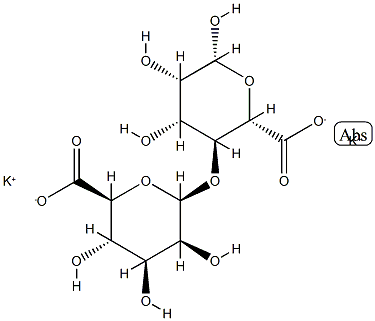POTASSIUM ALGINATE
- CAS NO.:9005-36-1
- Empirical Formula: C12H16K2O13
- Molecular Weight: 446.44424
- MDL number: MFCD17214229
- EINECS: 000-000-0
- Update Date: 2024-12-18 14:15:32

What is POTASSIUM ALGINATE?
Chemical properties
Occurs in filamentous, grainy, granular, and powdered forms. It is colorless or slightly yel- low and may have a slight characteristic smell and taste. Slowly soluble in water, forming a viscous solution; insoluble in alcohol.
Chemical properties
Potassium alginate occurs as a white to yellowish, fibrous or granular powder; it is almost odorless and tasteless.
The Uses of POTASSIUM ALGINATE
Potassium Alginate is a gum that is the potassium salt of alginic acid. It is soluble in cold water, forming a viscous colloidal solution. It functions as a stabilizer, thickener, and gelling agent. It is used in dietetic foods, low-sodium foods, dry mixes, and dental impression material. Typical usage levels range from 0.05 to 0.50%.
The Uses of POTASSIUM ALGINATE
Thickening agent and stabilizer in dairy prod- ucts, canned fruits, and sausage casings; emulsifier. See alginic acid.
Definition
Hydrophilic colloid having a molecular weight of 32,000–250,000.
Production Methods
Alginate obtained from brown seaweed is subjected to demineralization, extraction, and precipitation of alginic acid. Following neutralization, the potassium alginate obtained is dried and milled.
Pharmaceutical Applications
Potassium alginate is widely used in foods as a stabilizer, thickener, and emulsifier; however, its use as a pharmaceutical excipient is currently limited to experimental hydrogel systems. The viscosity, adhesiveness, elasticity, stiffness, and cohesiveness of potassium alginate hydrogels have been determined and compared with values from a range of other hydrogel-forming materials.The effect of calcium ions on the rheological properties of procyanidin hydrogels containing potassium alginate and intended for oral administration has also been investigated.
Safety
Potassium alginate is widely used in food products. It is currently used as an excipient only in experimental pharmaceutical formulations.
storage
In the solid state, potassium alginate is a stable material that is not
prone to microbial spoilage. Over time, a slow reduction in the
degree of polymerization can occur, which may be reflected in a
reduction in the viscosity of solutions. As both temperature and
moisture can impair the performance of potassium alginate, storage
below 25°C is recommended.
Potassium alginate solutions are stable at pH 4–10; long-term
storage outside this range can result in depolymerization of the
polymer through hydrolysis. Gelation or precipitation of the
alginate can occur at pH values less than 4. Liquid or semisolid
alginate formulations should be preserved: suitable preservatives
are sodium benzoate, potassium sorbate, or parabens.
Potassium alginate should be stored under cool, dry conditions
in a well-closed container.
Incompatibilities
Incompatible with strong oxidizers.
Regulatory Status
GRAS listed. Accepted for use in foods in the USA and Europe.
Properties of POTASSIUM ALGINATE
| solubility | Potassium alginate is soluble in water, dissolving to
form a viscous hydrophilic colloidal solution. It is insoluble in
ethanol (95%) and in hydroalcoholic solutions in which the
alcohol content is greater than 30% by weight; also insoluble in
chloroform, ether, and acids having a pH lower than about 3.
When preparing solutions of potassium alginate it is important
to ensure proper dispersion of the particles, as poor dispersion
will lead to the formation of large lumps of unhydrated powder
and significantly extended hydration times. |
| Odor | at 100.00?%. odorless |
| EPA Substance Registry System | Alginic acid, potassium salt (9005-36-1) |
Safety information for POTASSIUM ALGINATE
Computed Descriptors for POTASSIUM ALGINATE
POTASSIUM ALGINATE manufacturer
Kamman Group
Snap Natural And Alginate Products Pvt Ltd
New Products
(S)-3-Aminobutanenitrile hydrochloride 4-Methylphenylacetic acid N-Boc-D-alaninol N-BOC-D/L-ALANINOL Tert-butyl bis(2-chloroethyl)carbamate 3-Morpholino-1-(4-nitrophenyl)-5,6-dihydropyridin- 2(1H)-one Furan-2,5-Dicarboxylic Acid Tropic acid 1-Bromo-3,5-Di-Tert-Butylbenzene S-2-CHLORO PROPIONIC ACID ETHYL ISOCYANOACETATE 2-Bromo-1,3-Bis(Dimethylamino)Trimethinium Hexafluorophosphate 4-IODO BENZOIC ACID 3-NITRO-2-METHYL ANILINE 1-(2,4-DICHLOROPHENYL) ETHANAMINE (2-Hydroxyphenyl)acetonitrile 4-Bromopyrazole 2-(Cyanocyclohexyl)acetic acid 4-methoxy-3,5-dinitropyridine 1-(4-(aminomethyl)benzyl)urea hydrochloride 2-aminopropyl benzoate hydrochloride diethyl 2-(2-((tertbutoxycarbonyl)amino) ethyl)malonate tert-butyl 4- (ureidomethyl)benzylcarbamate Ethyl-2-chloro((4-methoxyphenyl)hydrazono)acetateRelated products of tetrahydrofuran








You may like
-
 9005-36-1 Potassium alginate 99%View Details
9005-36-1 Potassium alginate 99%View Details
9005-36-1 -
 9005-36-1 99%View Details
9005-36-1 99%View Details
9005-36-1 -
 Potassium alginate 98%View Details
Potassium alginate 98%View Details
9005-36-1 -
 Potassium alginate CAS 9005-36-1View Details
Potassium alginate CAS 9005-36-1View Details
9005-36-1 -
 ALGINIC ACID, POTASSIUM SALT CAS 9005-36-1View Details
ALGINIC ACID, POTASSIUM SALT CAS 9005-36-1View Details
9005-36-1 -
 1975-50-4 98%View Details
1975-50-4 98%View Details
1975-50-4 -
 14714-50-2 (2-Hydroxyphenyl)acetonitrile 98+View Details
14714-50-2 (2-Hydroxyphenyl)acetonitrile 98+View Details
14714-50-2 -
 118753-70-1 98+View Details
118753-70-1 98+View Details
118753-70-1